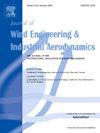Study on the law of dust isolation by three-dimensional adjustable rotating flow air curtain in fully mechanized mining face
IF 4.9
2区 工程技术
Q1 ENGINEERING, CIVIL
Journal of Wind Engineering and Industrial Aerodynamics
Pub Date : 2025-04-10
DOI:10.1016/j.jweia.2025.106096
引用次数: 0
Abstract
In order to effectively isolate the dust generated during coal mining operations and reduce the dust diffusion to the working area, this paper designs an air curtain which can be adjusted in three directions and installed on the rocker arm of shearer. Through the numerical simulation the air curtain dust isolation law was studied, when the air curtain outlet wind velocity (Vac), the distance between the air curtain and the shearer drum front (Dad), the distance between the air curtain and the shearer body (Das), the airflow injection angle (), the inlet wind velocity of the roadway (Vin) and other parameters changed, and the best parameters were chosen. According to the numerical simulation results, the dust isolation efficiency near the shearer's working area can reach 93 %, and the dust isolation efficiency in the downwind area of the shearer can reach 84 %. Based on the numerical simulation, a similar model is established and the experiment is carried out. The experimental results showed that the dust isolation effect of the similar model is similar to that of the numerical simulation. This study provides theoretical and practical value for effective isolation of dust.
综采工作面三维可调旋流风幕隔尘规律研究
为了有效隔离煤矿开采过程中产生的粉尘,减少粉尘向工作区域的扩散,本文设计了一种安装在采煤机摇臂上的可三方向调节的气幕。通过数值模拟研究了风幕出口风速(Vac)、风幕与采煤机滚筒前方距离(Dad)、风幕与采煤机机体距离(Das)、气流注入角(θ)、巷道入口风速(Vin)等参数变化时的风幕粉尘隔离规律,并选择出最佳参数。数值模拟结果表明,采煤机工作区域附近的隔尘效率可达93%,采煤机下风区域的隔尘效率可达84%。在数值模拟的基础上,建立了相似的模型,并进行了实验。实验结果表明,相似模型的隔尘效果与数值模拟相似。该研究为有效隔离粉尘提供了理论和实用价值。
本文章由计算机程序翻译,如有差异,请以英文原文为准。
求助全文
约1分钟内获得全文
求助全文
来源期刊
CiteScore
8.90
自引率
22.90%
发文量
306
审稿时长
4.4 months
期刊介绍:
The objective of the journal is to provide a means for the publication and interchange of information, on an international basis, on all those aspects of wind engineering that are included in the activities of the International Association for Wind Engineering http://www.iawe.org/. These are: social and economic impact of wind effects; wind characteristics and structure, local wind environments, wind loads and structural response, diffusion, pollutant dispersion and matter transport, wind effects on building heat loss and ventilation, wind effects on transport systems, aerodynamic aspects of wind energy generation, and codification of wind effects.
Papers on these subjects describing full-scale measurements, wind-tunnel simulation studies, computational or theoretical methods are published, as well as papers dealing with the development of techniques and apparatus for wind engineering experiments.

 求助内容:
求助内容: 应助结果提醒方式:
应助结果提醒方式:


